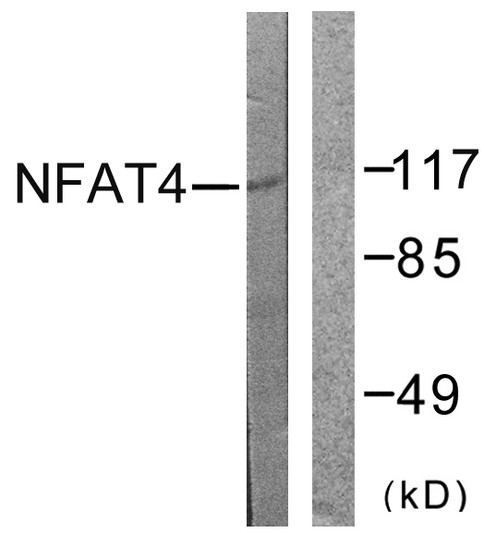| Tissue Specificity | Isoform 1: Predominantly expressed in thymus and is also found in peripheral blood leukocytes and kidney. Isoform 2: Predominantly expressed in skeletal muscle. Also found weakly expressed in the thymus, kidney, testis, spleen, prostate, ovary, small intestine, heart, placenta and pancreas. Isoform 3: Expressed in thymus and kidney. Isoform 4: Expressed in thymus and skeletal muscle. |
| Post Translational Modifications | Ubiquitinated by STUB1/CHIP, leading to proteasomal degradation. Phosphorylated by NFATC-kinase.dephosphorylated by calcineurin. |
| Function | Acts as a regulator of transcriptional activation. Binds to the TNFSF11/RANKL promoter region and promotes TNFSF11 transcription. Binding to the TNFSF11 promoter region is increased by high levels of Ca(2+) which induce NFATC3 expression and may lead to regulation of TNFSF11 expression in osteoblasts. Plays a role in promoting mesenteric arterial wall remodeling in response to the intermittent hypoxia-induced increase in EDN1 and ROCK signaling. As a result NFATC3 colocalizes with F-actin filaments, translocates to the nucleus and promotes transcription of the smooth muscle hypertrophy and differentiation marker ACTA2. Promotes lipopolysaccharide-induced apoptosis and hypertrophy in cardiomyocytes. Following JAK/STAT signaling activation and as part of a complex with NFATC4 and STAT3, binds to the alpha-beta E4 promoter region of CRYAB and activates transcription in cardiomyocytes. In conjunction with NFATC4, involved in embryonic heart development via maintenance of cardiomyocyte survival, proliferation and differentiation. Plays a role in the inducible expression of cytokine genes in T-cells, especially in the induction of the IL-2. Required for thymocyte maturation during DN3 to DN4 transition and during positive selection. Positively regulates macrophage-derived polymicrobial clearance, via binding to the promoter region and promoting transcription of NOS2 resulting in subsequent generation of nitric oxide. Involved in Ca(2+)-mediated transcriptional responses upon Ca(2+) influx via ORAI1 CRAC channels. |
| Protein Name | Nuclear Factor Of Activated T-Cells - Cytoplasmic 3Nf-Atc3Nfatc3NfatxT-Cell Transcription Factor Nfat4Nf-At4Nf-At4c |
| Database Links | Reactome: R-HSA-2025928Reactome: R-HSA-2871809Reactome: R-HSA-5607763 |
| Cellular Localisation | CytoplasmNucleusThe Subcellular Localization Of Nfatc Plays A Key Role In The Regulation Of Gene TranscriptionRapid Nuclear Exit Of Nfatc Is Thought To Be One Mechanism By Which Cells Distinguish Between Sustained And Transient Calcium SignalsCytoplasmic When Phosphorylated And Nuclear After ActivationThat Is Controlled By Calcineurin-Mediated DephosphorylationTranslocation To The Nucleus Is Increased In The Presence Of Calcium In Pre-OsteoblastsTranslocates To The Nucleus In The Presence Of Edn1 Following Colocalization With F-Actin FilamentsTranslocation Is Rock-DependentTranslocates To The Nucleus In Response To Lipopolysaccharide Treatment Of Macrophages |
| Alternative Antibody Names | Anti-Nuclear Factor Of Activated T-Cells - Cytoplasmic 3 antibodyAnti-Nf-Atc3 antibodyAnti-Nfatc3 antibodyAnti-Nfatx antibodyAnti-T-Cell Transcription Factor Nfat4 antibodyAnti-Nf-At4 antibodyAnti-Nf-At4c antibodyAnti-NFATC3 antibodyAnti-NFAT4 antibody |
Information sourced from Uniprot.org










